If there’s any hair styling tool I adore more than the rest, it has to be my flat iron.
If you’re reading this, you probably feel the same way.
I mean, what other tool in your arsenal can get your hair lusciously smooth with just a few swipes?
But alas, the things we love the most are usually the things that hurt us the most. Or in this case, hurt our hair the most.
So how can you fix flat-iron damaged hair if you’ve gone and overdone it this time? Is your hair even salvageable?
How Heat Styling Damages Your Hair
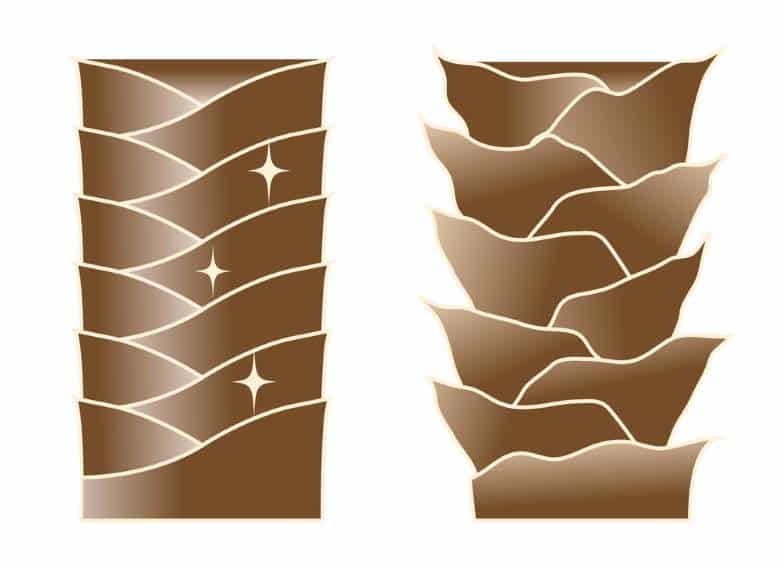
Hair that comes into contact with extremely high temperatures often get damaged because the cuticle, or outer layer opens up. (Likewise, rinsing your hair with hot water does the same thing.)
Since your cuticle layer acts as an exterior barrier, when it opens up, it exposes your inner hair shaft to all the elements.
An open cuticle also makes it incredibly difficult for hair to retain any moisture, which is why your hair can start to feel dry and straw-like if you straighten your hair a lot.
High heat also breaks down the proteins that make up your hair structure. When these proteins bonds are broken, your hair becomes weak, brittle, and breaks off easily.
The thing is, you won’t necessarily notice damage right away. It takes time to build up and gradually becomes worse.
The more you straighten (or even dry your hair with high heat), the worse your hair will get over time if you don’t take steps to protect it.
Before long, the only way to save your hair will actually be to cut it off. This could result in losing several inches of hair if you go too long without a regular trim.
Not Using Heat Protectant
One of the biggest mistakes many gals make when straightening their hair is not using heat protectant before styling.
I know it’s tough to add an additional step to your morning routine, especially if you’re always in a rush to get out the door (or onto a Zoom meeting).
But this is one of the most important steps you should take to combat heat damage.
Always apply some heat protectant evenly to all your strands so they’re adequately protected from your flat iron’s hot plates.
Cranking The Heat Up Too High
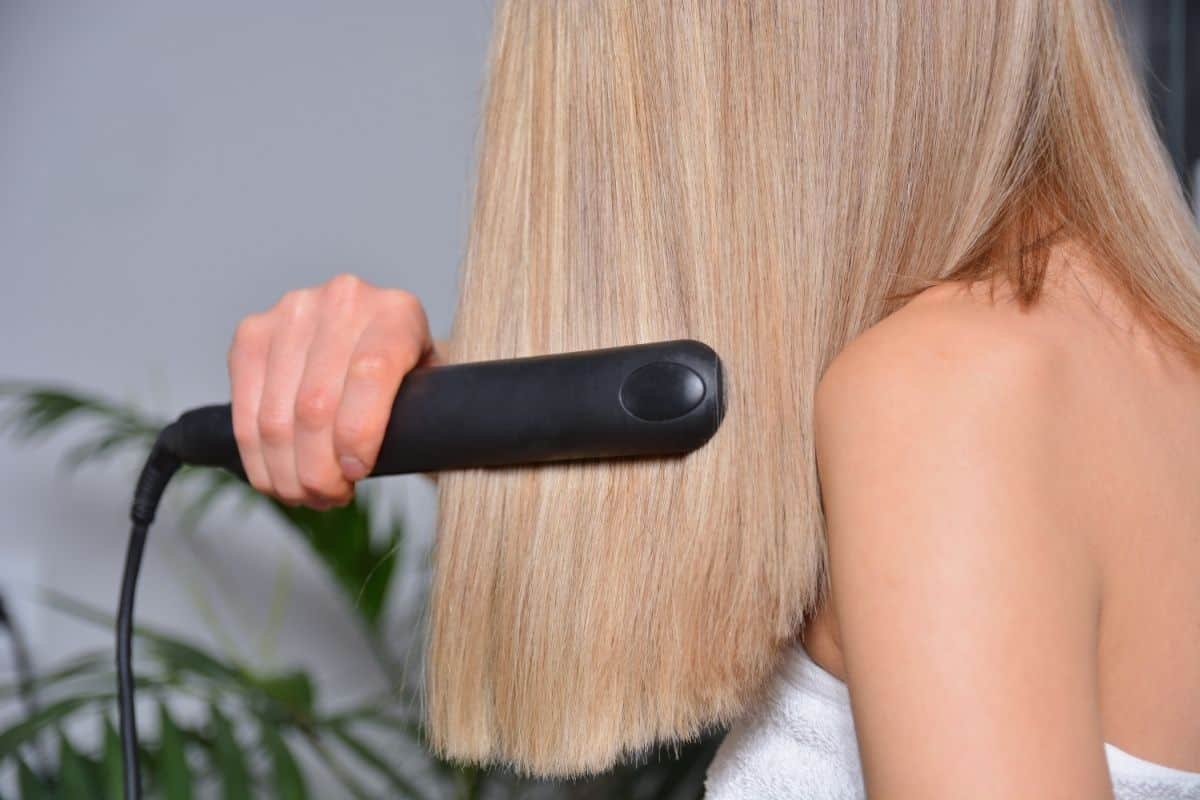
The other biggie when it comes to flat-iron-burnt hair is using too high a temperature for your hair type.
I know it’s tempting to crank the heat up so you can finish straightening sooner.
But you should find the lowest heat setting needed to straighten your tresses and DON’T GO OVER it.
How to Identify Heat-Damaged Hair
There are a few things you can keep an eye out for if you think you might have heat-damaged hair. Here are some dead giveaways:
Your Hair Looks Frizzy and You Have Flyaways
Frizziness is one of the most common and annoying signs that your hair has been damaged by heat.
When you start to notice that your once-sleek, beautiful glass hair is looking frizzy, it’s probably damaged.
Flyaways will also become more frequent and irritating.
Dehydration from high heat can make hair unruly and a pain to deal with as dry strands tend to get caught on each other and generally lose it’s shine and elasticity.
You Lose Volume
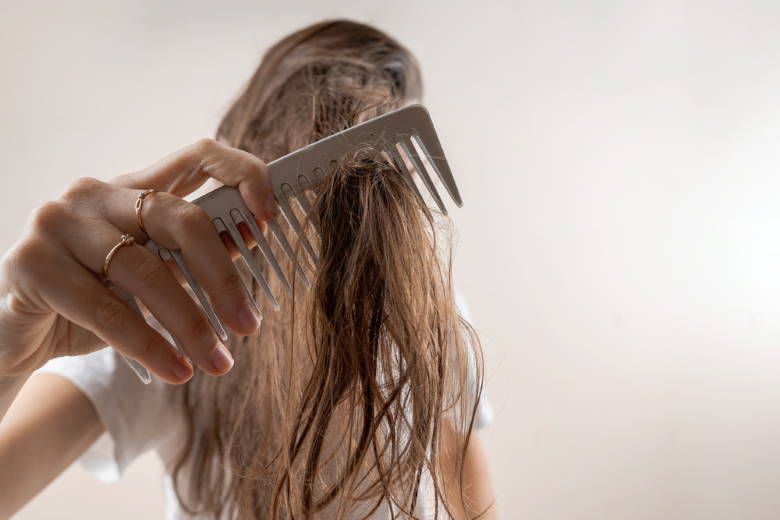
If your hair seems to be thinner than it used to be, it’s possible that you have heat damaged strands.
If this happens, be extra careful about flat-ironing until you’ve found a solution.
One thing you can try is to add a protein-rich conditioner into your hair care routine.
Another option would be to switch to a sulfate-free shampoo.
Your Hair Feels Rough
When you have heat damaged hair, it tends to feel quite rough. If high levels of heat are used on the hair, cracks are created in the cuticles and your hair loses moisture from the cortex, which is under the cuticle.
You can try hydrating your hair as much as possible and using all the leave-in conditioner in the world, but this won’t change the fact that you have heat damage.
One thing to avoid when your hair feels rough is touching it too much, as this can damage it further.
If you are experiencing any of these issues, visit your hairdresser to discuss solutions. They’ll be able to help you identify what exactly is causing your hair problems, and they’ll know how to treat them.
However, since the dryness of your hair is caused by heat, you can start by refraining from heat styling for a while.
You can also start washing and rinsing your hair with cool water so you don’t lose more moisture.
You’re Shedding More Than Usual
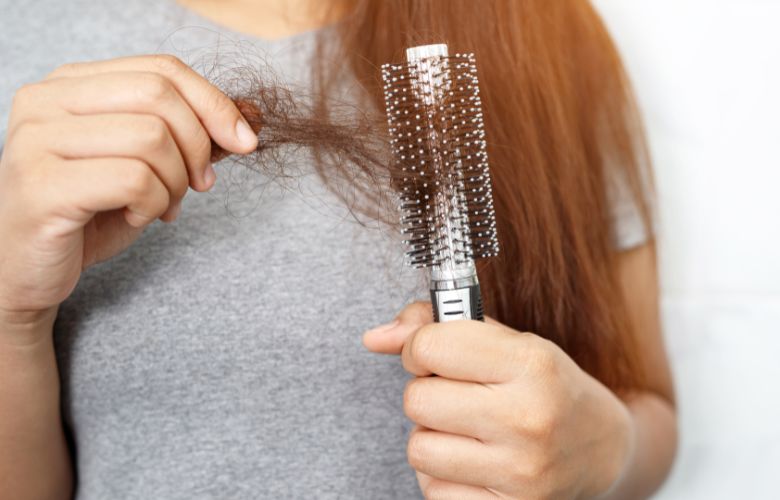
On average, the typical person will shed anywhere between 50 and 100 hair strands every day. Heat damaged hair, on the other hand, can shed a lot more.
This is primarily due to the constant tugging and pulling on your strands, which weakens the roots. After a while, your hair follicles will begin shedding more regularly.
If you notice that you’re shedding more than usual, it’s most likely that you’ve incurred some heat damage. If you’re noticing that there’s a lot more hair left in the shower than there used to be, you should be concerned.
If this is the case, take extra care when you wash your hair. Be gentle while washing your hair, and towel dry with a microfiber towel.
Your Hair has Less Elasticity and Bounce to it
Heat damaged hair typically doesn’t have much bounce or give to it, and can seem lifeless and dull.
Your hair can also lose its elasticity, so you’ll need to be really careful when you blow dry your hair.
Elasticity enables your hair to be stretched out, then retain the shape it has. You can test this out by grabbing a strand of your hair and gently stretching it by pulling it.
If your hair is able to stretch a little before returning to its usual shape, there’s a good chance that it’s fine.
If, however, the strand of hair snaps off from the tension, you probably have damaged hair.
This is an especially important factor for those with curly hair. When curly hair gets damaged, the curls often aren’t as bouncy or springy as they once were.
For those with straight hair, you’re likely to notice that even if you curl your hair, it will not retain a curl the way it used to.
Split Ends and Breakage
When hair is damaged by excessive heat, it becomes brittle and prone to breakage.
In addition, you may find lots of split ends if you look closely at your ends.
When you do manage to get through one without falling apart, you’ll see that it looks quite different from normal hair. It’ll look sort of grayish and lifeless.
Since your hair’s protein bonds are easily broken with extreme heat, there will be a lot more breakage and split ends.
This breakage can be extreme, and result in inches of hair being lost. While brushing your hair, this is likely to be especially noticeable.
If you notice that you have a lot more flyaways than normal, this is typically because of hair breakage. All the shorter strands you notice sticking out are already broken off, which is exactly what you don’t want.
Knotty and Tangled Hair
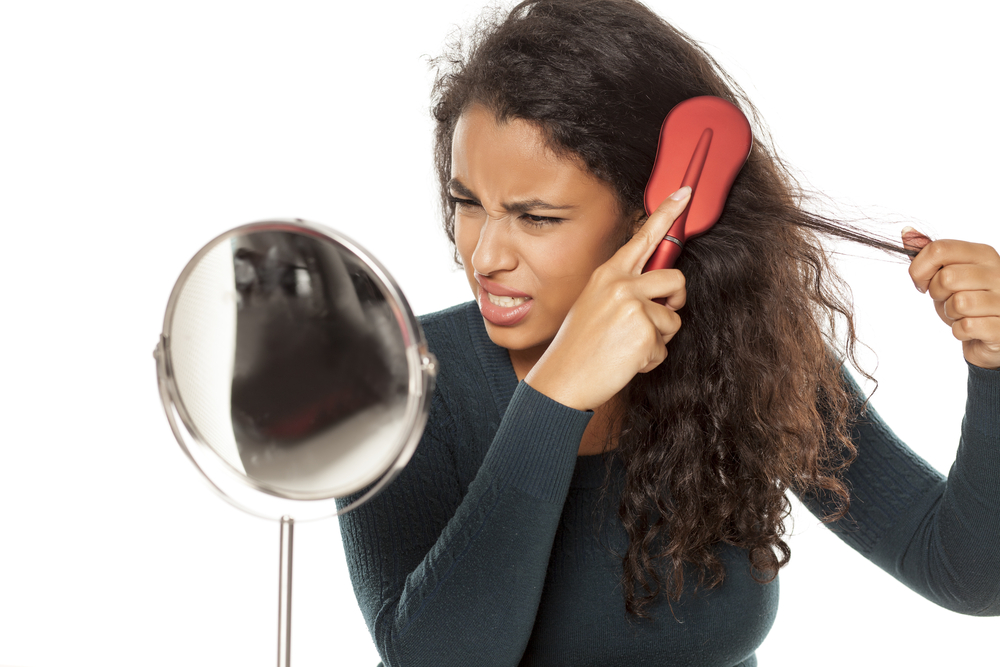
While heat damage isn’t the only thing that causes knots and tangles in your hair, it’s the main culprit.
Heat damaged hair is extremely prone to knotting and tangling because it tends to be much weaker than healthy hair.
Because of this, it’s actually easier to create knots and tangles in damaged hair than in healthy hair. This makes it imperative to keep your hair free of knots and tangles when flat ironing.
Since your cuticles are arranged like shingles on a roof, once they open up, the external layer is no longer smooth. The cuticles from one strand then start to tangle with cuticles from other hair strands, causing knots to form.
We all know the struggles of trying to brush knotty hair, and we all want to avoid it! You’d be surprised by how quickly and easily hair will become knotty, even if it’s just been brushed out.
Fixing Heat Damaged Hair
One of the most effective things you can do for burnt, damaged hair is use a sulfate-free shampoo and conditioner.
Sulfate-free shampoos generally use milder cleansers that won’t strip away the natural oils that naturally soften your hair.
You can also try repairing the damage a DIY treatment, some of which work better than others. We’ll go into some of these below.
You should also look into styling tools that provide heat protection. As mentioned before, these tools aren’t going to undo the damage, but they’ll at least minimize the effects.
Apply Olive Oil on the Burnt Area
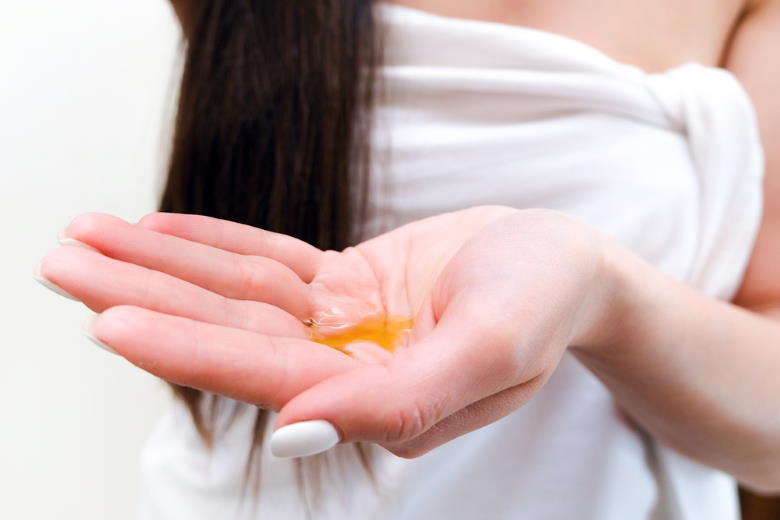
For an immediate solution to burnt hair, apply some olive oil to the affected strands.
A pea-sized amount of oil will do – rub it between your palms and then coat the burnt strands with it. This should smooth out the dry, brittle feel to the strands while protecting them from further damage.
Another benefit to applying olive oil is that it helps mask the unpleasant smell of burnt hair. It penetrates the hair shaft to moisturize and condition, and the natural emollients in olive oil help seal the rough cuticle layer back down.
If you don’t have any olive oil on hand, you can apply a leave-in conditioner the same way.
Deep Condition Your Hair
In terms of ongoing care, you’ll want to deep condition damaged strands regularly to keep them from deteroriating further.
Deep conditioning your hair is very beneficial as it helps seal the cuticle and conditions and hydrates fried hair. The process takes longer than normal conditioning, but it’s worth the effort.
Depending on your hair type, you can use either a protein-based deep conditioner or a moisturizing one.
When it comes to deep conditioning, you need to bear in mind that it is easy to over do it. Whether your hair is lacking moisture or protein, there is such a thing as too much. When you deep condition your hair too much, it can also get damaged.
If you deep condition once a week, you’ll see significant improvements in your hair. It will feel softer, shinier, and look healthier.
For seriously damaged locks, consider deep conditioning with heat. You can do this by using steam or other means. By using heat with your conditioner, the results are typically better. This makes it a great option for hair that is really dried out!
Use a Bond Repair Treatment
When you’ve fried or otherwise damaged your hair (either from excessive heat or chemical processing), the protein bonds that make up your hair structure get weakened.
To help repair these broken bonds, using a bond-building or bond repair treatment will go a long way towards strengthening and repairing breakage.
Bond repair treatments are fantastic because they create new bonds in damaged hair to restore the integrity of each strand and bring fried or overprocessed hair back to life.
For serious damage, you’ll want to consult your hairdresser, as some of these treatments will need to be professionaly done for you in the salon, such as Olaplex Nos. 1 and 2.
Olaplex No. 3 is an at-home treatment you can use to repair and strengthen damaged locks.
How Long To Leave Olaplex No. 3 On Hair
Use A Reparative Shampoo And Conditioner
There are different types of shampoos and conditioners designed specifically for damaged hair. Some of them contain ingredients such as honey or avocado oil.
Others have anti-frizz properties. Whatever type you choose, read the label to ensure that there are no harmful chemicals in the formula.
When shopping around for a new shampoo and conditioner, you might notice that some brands claim to “repair” hair. But what does that mean? Does it actually work?
It doesn’t. Repairing hair means that the manufacturer claims that their product will reduce the amount of damage to your hair.
That’s because they usually contain certain ingredients, like peptides, that act as natural moisturizers. But they don’t really repair your hair.
For hair proteins to be recreated (short of growing new hair), you need the patented ingredient found in the Olaplex line of bond treatments – bis-aminopropyl diglycol dimaleate.
So aside from the No. 3 Hair Perfector, you may want to consider adding Olaplex No. 4 (Bond Maintenance Shampoo) and No. 5 (Bond Maintenance Conditioner) to your shower caddy.
Of course, as a premium hair care product, not everyone can afford it.
As long as you are using products that are moisturizing and have no harsh chemicals, they will do the job. These products should contain keratin, in addition to other ingredients that will help restore damaged hair.
Products with rich formulas that include UVA/UVB protection, antioxidants, nutrients, and ceramides are highly recommended.
Humectants such as glycerin and panthenol are also beneficial to have in the formulation. This is because humectants help pull moisture in from the air and keep hair hydrated.
Hot Oil Treatments
When we say hot oil, we really mean WARM oil. It’s incredibly easy to burn yourself, so always be very careful when doing this.
And to be clear, this is different than the olive oil application immediately after burning your hair.
You’ll want to reserve a few hours to apply, wash, and rinse the oils out. It’s best if you’re not planning to head out for the night either.
The good news is you can still use any plant-based oil blend (such as olive, coconut, grapeseed, or avocado) you have at home.
Check this out for detailed directions on how to DIY a hot oil treatment at home.
Find a Heat-Free Alternative
There are heat-free alternatives out there that you can try out to straighten your hair (or curl it). The whole point is to get away from using heat on your hair, so we want to try to avoid using heat tools to achieve straight or curly hair.
Luckily, there are a couple of things you can do to achieve this in a way that your hair will be grateful for.
If you want to get frizz free hair without using heat, apply a leave-in conditioner to your hair.
Doing this will help keep the frizz at bay while your hair is recovering. You can also use hair serums if you wish.
Curl enhancers are great for people who already have curly hair – they will make your curls look even more beautiful! Alternatively, you can try out various hairstyles to achieve a different hair result.
You can try French braids or classic braids for wavy hair, or you could simply tie your hair in a lavish ponytail.
Get a Haircut
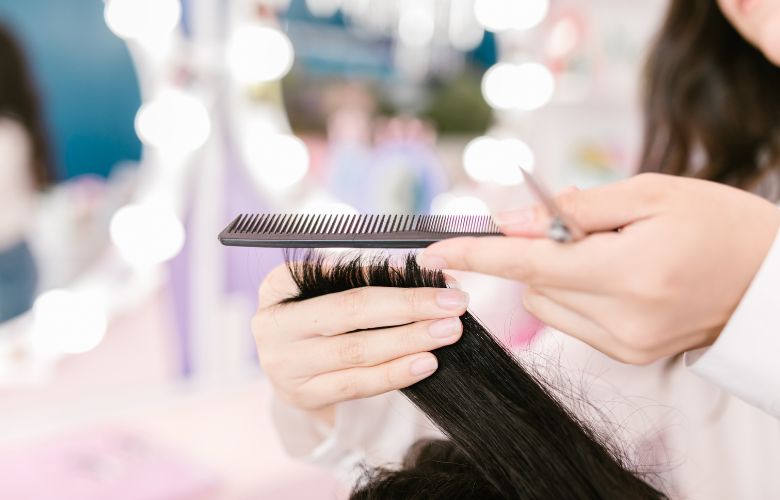
Most of the time, heat damaged hair simply needs to be grown out then cut off. You will probably want to allow your hair to grow out as much as you can, then cut it.
This will get rid of all the damaged parts, and allow you to start fresh with healthy hair. While you grow your hair out, you will need to make a conscious effort to take care of it.
While hair does grow out, it takes a while. Be careful to take care of it from the start and avoid overdoing it with your flat iron.
It’s not the most fun option, but it’s the best way to get rid of damaged hair.
Avoiding Heat Damage
The best way to avoid burnt hair is to prevent heat damage in the first place.
While hair products alone will not completely prevent heat damage, they can certainly make a difference.
A good shampoo will remove buildup from styling products, and a conditioning treatment will add back a bit of shine and luster.
The best combo for flat ironing is applying heat protectant evenly across all your strands and using the lowest heat setting that your hair requires.
A great deal of damage occurs during the first few months after your hair has started growing. Damage accumulates over time, but you can definitely take steps to protect your hair from getting so hot.
You can do a couple of things to avoid heat damage from ever being a problem. We’ll go through these things below so that you can do everything in your power to keep healthy hair.
Use a Heat Protectant
The number one thing to start doing if you aren’t already is to thoroughly apply a good heat protectant each and every time before you straighten.
Heat protectant acts as a barrier between your straightener’s super hot plates and your delicate strands.
If you don’t protect your hair properly, you’ll end up causing further damage.
An ounce of prevention is better than a pound of cure.
Make Sure Your Hair is Dry Before Styling
You should never try to straighten your hair while it is still damp or wet. Steam damage will boil your hair from the inside out!
Always dry your hair thoroughly before getting the flat iron out.
(Unless you’re specifically using a wet-to-dry flat iron.)
Deep Condition With Protein
To give your hair the best possible chance of growing back strong and healthy, use a protein treatment.
Protein deep conditioners help repair split ends, and generally make your hair stronger and more able to withstand whatever you do to it.
They can also help prevent breakage by strengthening the bonds between hair’s keratin molecules.
It’s important to note that when you choose to buy a protein treatment, be careful to not over do it.
You can give your hair too much protein, too! When this happens, your hair will actually weaken.
Get a Moisturizing Shampoo
A moisturizing shampoo helps hydrate and detangle your hair, giving it a smoother feel.
Most moisturizing shampoos will work just fine, but if you find one that doesn’t suit your hair, switch brands. Don’t worry about it, though – there are plenty of great ones available.
Reduce the Use of Hot Styling Tools
Hot tools like flat irons and curlers are used to style hair quickly, but they can cause serious damage if you aren’t careful. The high temperatures caused by hot tools can actually melt the hair shaft and cause damage.
Try to limit their usage to only those times when you absolutely have to get a job done fast.
Try Alternatives to a Flat Iron
Instead of damaging your hair with heat, try braiding or putting your hair in an updo as an alternative.
Save your flat iron for the truly important dates or events that you really NEED your hair straightened for.
Final Thoughts
Flat irons are a gal’s best friend, but they can literally burn you (and your hair) if used excessively.
Instead of suffering the consequences of overused heat, try to take care of your hair from the very start. Limit how often you use hot tools for styling, and try to find alternatives wherever possible.
Cause you know how it goes – burn me once, shame on you (flat iron), burn me twice, shame on me! Don’t let it happen again if you can help it!

